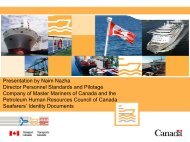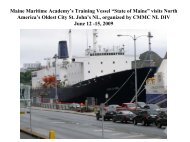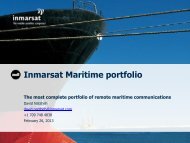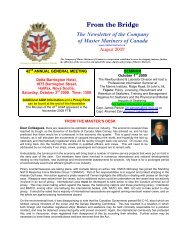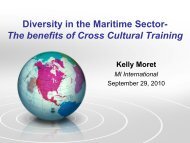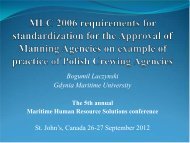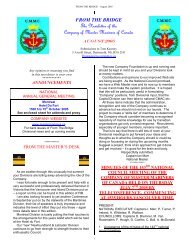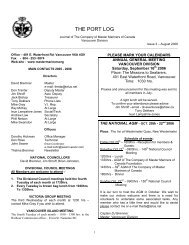From the Bridge - Company of Master Mariners of Canada
From the Bridge - Company of Master Mariners of Canada
From the Bridge - Company of Master Mariners of Canada
You also want an ePaper? Increase the reach of your titles
YUMPU automatically turns print PDFs into web optimized ePapers that Google loves.
“<strong>From</strong> <strong>the</strong> <strong>Bridge</strong>” August 2007<br />
funding to build <strong>the</strong> Centre. The Centre will be a West Coast hub <strong>of</strong> maritime activity and education. It will<br />
showcase our role in Asia Pacific trade, our Aboriginal roots and our dependence on <strong>the</strong> marine environment.<br />
The location in federally designated heritage shipyard on <strong>the</strong> waterfront at <strong>the</strong> centre <strong>of</strong> <strong>Canada</strong>’s largest and<br />
busiest port is ideal. It is close to <strong>the</strong> Burrard Dry Docks, to <strong>the</strong> Port and to Lonsdale Quay. Access to <strong>the</strong> City <strong>of</strong><br />
Vancouver is easy via <strong>the</strong> Seabus. A significant part <strong>of</strong> BC’s shipbuilding industry was once situated on <strong>the</strong> site.<br />
The St Roch and o<strong>the</strong>r famous ships were built <strong>the</strong>re.<br />
More than a museum, <strong>the</strong> Centre will be a destination for people to celebrate, discover and participate in <strong>the</strong><br />
unique maritime fabric <strong>of</strong> <strong>the</strong> west coast. The Centre will <strong>of</strong>fer interactive and educational exhibits celebrating<br />
stories from First Nations Coast, <strong>the</strong> Frozen North, Shipbuilding, Navigation & Working Boats, Ocean Trade,<br />
Oceanography, Underwater Exploration, Immigration and much more. The Centre will serve as a training centre<br />
for all aspects <strong>of</strong> maritime activities such as boating safety and restoration – promoting active, experiential<br />
learning on <strong>the</strong> water and on land.<br />
http://www.vancouvermaritimemuseum.com/sites/vmmuseum/files/NMC-City_NV_NR_Jan_11_06.pdf<br />
This announcement about <strong>the</strong> funding was made at a presentation attended by Captain Alan Shard, Vancouver<br />
Division, who was <strong>the</strong>ir by invitation as a member <strong>of</strong> CMNVA.<br />
MSC Napoli Refloated<br />
On July 7 th 2007 <strong>the</strong> Mediterranean Shipping <strong>Company</strong> (www.mscgva.ch) container ship Napoli was refloated. The<br />
53,409 gross tons vessel had been deliberately grounded on <strong>the</strong> south coast <strong>of</strong> Devon in England almost six<br />
months earlier. Cracks in <strong>the</strong> hull had prompted <strong>the</strong> decision to beach <strong>the</strong> vessel <strong>of</strong>f <strong>the</strong> “World Heritage Coast”<br />
amid fears it would sink and be more <strong>of</strong> a hazard to <strong>the</strong> environment. The ship had been run aground deliberately<br />
during a violent storm in January. The crew was rescued by helicopter but numerous sea birds were killed by<br />
leaking oil. More than 100 containers were lost overboard, many washing ashore to be scavenged by people on<br />
<strong>the</strong> beach.<br />
On January 18 th <strong>the</strong> MSC Napoli, en route from Antwerp to South Africa, suffered severe damage during a storm<br />
in <strong>the</strong> English Channel. SMIT Salvage (www.smit.com) was contracted to salvage <strong>the</strong> vessel. This included <strong>the</strong><br />
discharge <strong>of</strong> 2,300 containers followed by <strong>the</strong> refloating <strong>of</strong> <strong>the</strong> vessel.<br />
About 4,000 tons <strong>of</strong> bunker oil was safely removed. Then a barge<br />
equipped with two cranes lifted <strong>of</strong>f <strong>the</strong> containers, landing <strong>the</strong>m on<br />
shuttle barges. By <strong>the</strong> beginning <strong>of</strong> March all 860 containers had<br />
been removed from <strong>the</strong> ship’s deck. It <strong>the</strong>n took until mid-May<br />
before all containers had been discharged from <strong>the</strong> ship. The<br />
salvage crew involved a team <strong>of</strong> 40 people. Subsequently<br />
equipment was brought in to pump water out <strong>of</strong> various<br />
compartments.<br />
After being refloated, <strong>the</strong> ship was towed into deeper water to allow<br />
for closer inspection. A diving survey soon revealed that <strong>the</strong> ship<br />
was more severely damaged than was feared. So <strong>the</strong> decision was made to beach <strong>the</strong> ship again. The UK<br />
Secretary <strong>of</strong> State’s Representative (SOSREP) for Marine Salvage & Intervention working with <strong>the</strong> Maritime and<br />
Coastguard Agency (MCA) (www.mcga.gov.uk) made this decision after <strong>the</strong> inspection revealed that <strong>the</strong> vessel was<br />
incapable <strong>of</strong> being towed. Some cracks in <strong>the</strong> hull were as much as 3m wide in places. So <strong>the</strong> ship was beached<br />
again, on a high tide in a spot close to its original position. The hope was that <strong>the</strong> ship would break in two. If that<br />
succeeded <strong>the</strong>n <strong>the</strong> forward section could float away while <strong>the</strong> stern would remain in place on <strong>the</strong> seabed to be<br />
removed later.<br />
The two ends <strong>of</strong> <strong>the</strong> ship have now been separated but it took numerous attempts with controlled explosions to<br />
accomplish this. Preparations are being made to tow <strong>the</strong> forward section to a shipyard, possibly Harland & Wolff<br />
in Belfast, to be scrapped, <strong>the</strong> only equipment on board being <strong>the</strong> most essential pumps. The fate <strong>of</strong> <strong>the</strong> after<br />
section has to be decided although SMIT Salvage was awarded a contract to remove any remaining pollutants.<br />
The total cost <strong>of</strong> <strong>the</strong> salvage operation was expected to be about £50 million.<br />
A report appearing on <strong>the</strong> website <strong>of</strong> a maritime insurance provider, TT Club (www.ttclub.com), is critical <strong>of</strong> <strong>the</strong><br />
media but full <strong>of</strong> compliments towards:-<br />
8



